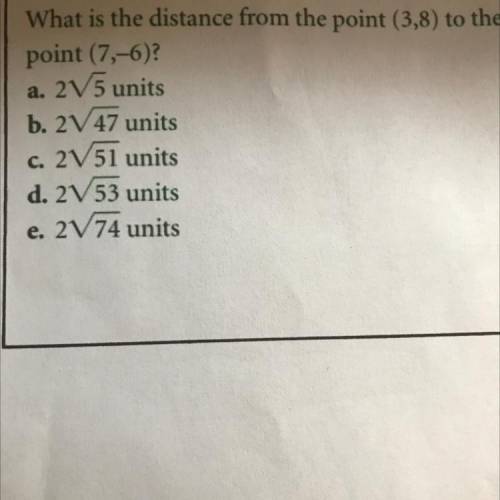20.
What is the distance from the point (3,8) to the
point (7,-6)?
a. 2V5 units
...

Mathematics, 26.08.2021 01:00 aletadaboss
20.
What is the distance from the point (3,8) to the
point (7,-6)?
a. 2V5 units
b. 2V 47 units
c. 2V 51 units
d. 2V53 units
e. 2V74 units


Answers: 2


Other questions on the subject: Mathematics

Mathematics, 21.06.2019 13:00, JonJon05
Which of the following situations represents a linear relationship? a. theresa increases the distance she runs by 0.1 miles every week. b. the volume of a box depends on the length of box. c. the amount of money in a bank account increases by 1 percent each year. d. the population of a town doubles every 5 years.
Answers: 3

Mathematics, 21.06.2019 18:30, letsbestupidcx7734
Two cyclists 84 miles apart start riding toward each other at the samen time. one cycles 2 times as fast as the other. if they meet 4 hours later what is the speed (in miles) of the faster cyclists
Answers: 2

Mathematics, 21.06.2019 19:30, TheViperMlg23676
When 142 is added to a number the result is 64 more times the number my options are 35 37 39 41
Answers: 1

Mathematics, 21.06.2019 21:30, gonzalezashley152
In a test for esp (extrasensory perception), the experimenter looks at cards that are hidden from the subject. each card contains either a star, a circle, a wave, a cross or a square.(five shapes) as the experimenter looks at each of 20 cards in turn, the subject names the shape on the card. when the esp study described above discovers a subject whose performance appears to be better than guessing, the study continues at greater length. the experimenter looks at many cards bearing one of five shapes (star, square, circle, wave, and cross) in an order determined by random numbers. the subject cannot see the experimenter as he looks at each card in turn, in order to avoid any possible nonverbal clues. the answers of a subject who does not have esp should be independent observations, each with probability 1/5 of success. we record 1000 attempts. which of the following assumptions must be met in order to solve this problem? it's reasonable to assume normality 0.8(1000), 0.2(1000)%30 approximately normal 0.8(1000), 0.2(1000)% 10 approximately normal srs it is reasonable to assume the total number of cards is over 10,000 it is reasonable to assume the total number of cards is over 1000
Answers: 1
You know the right answer?
Questions in other subjects:


Mathematics, 01.04.2020 00:00





Mathematics, 01.04.2020 00:00



Mathematics, 01.04.2020 00:00



